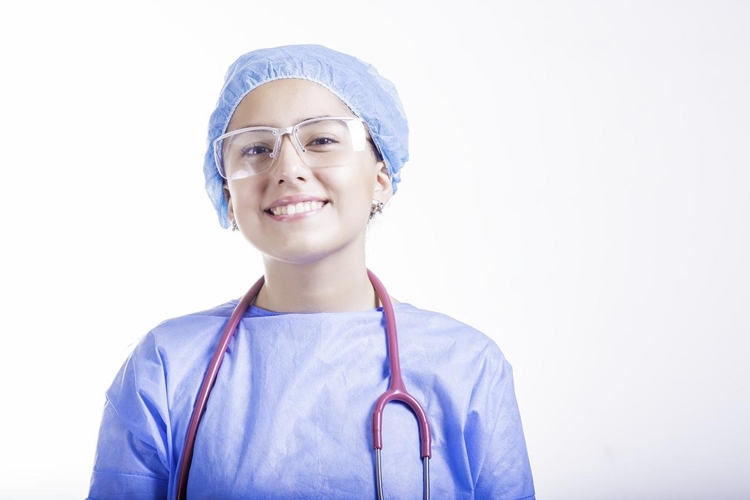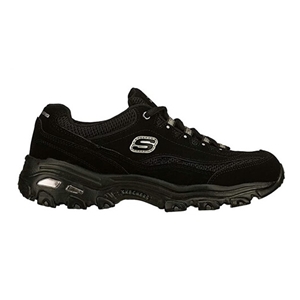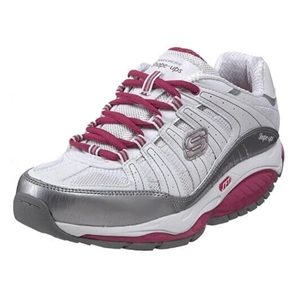Picking the right shoes for your daily life may mean deciding between ballet flats or heels, especially if you have a preference for a certain type of shoe.
Heels can length the appearance of your legs, make you taller, and feel much more confident either in the office or on a night out.

Many may consider ballet flats great for comfort and ease and keep heels for going out or special events, so they may believe that ballet flats are better than heels for most activities.
However, ballet flats aren’t always the best option, so comparing ballet flats to heels can help determine the best times to wear each type of shoe.
Are Ballet Flats Better For Your Feet Than Heels?
Comfort and support are important for any type of shoe that you’re wearing for longer periods of time, and poorly supported feet lead to pain and long-term problems that can significantly impact your life.
Both ballet flats and heels are popular and can perform better than the other in different situations. The short answer is that neither ballet flats nor heels are great as an everyday shoe, so picking the right shoe for the right situation is still important.

If you really had to pick between ballet flats and heels, go with the ballet flats, as heels are slightly more problematic for your long-term health.
Are Heels Good For Your Feet?
High heels are not known for being comfortable, easy to walk in, or even good for your feet overall. They can cause numerous problems for your feet, especially when jammed into a tight-fitting heel, and they can be problematic for your back and knees and even cause muscle spasms and cramps.
The worst type of heels have the thinnest heel making them the least stable and providing the least amount of support while you’re walking.
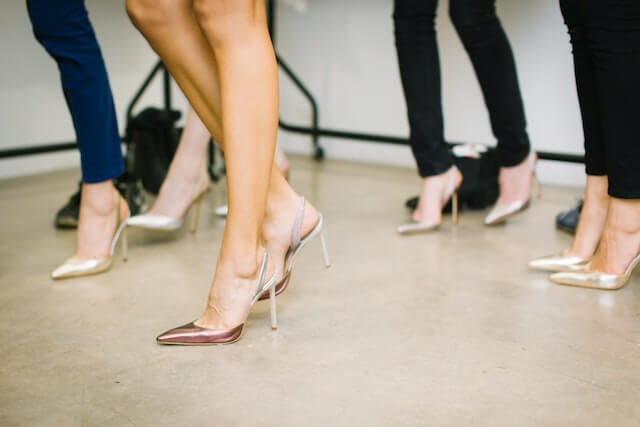
The way that most heels have been made has the majority of your weight resting on the ball of your foot rather than spread out and supported evenly and puts considerable pressure on your outer knee.
Heels are not good for you whether you can skillfully walk in them or not and should typically only be used for short periods of time for specific events or functions if long-term care of your feet, legs, and back are important.
To lessen problems with heels, consider keeping the heel less than two inches high, make sure that your heels aren’t too tight and provide room for your toes, and try to keep the heel as thick as possible.
Are Ballet Flats Good For Your Feet?
Ballet flats live up to their name and provide a completely flat sole so that no single point on your foot is taking all the pressure from your weight. They can be extremely comfortable, easy to wear and put on quickly, and often are very affordable.
However, ballet flats provide zero support for your foot and are almost the equivalent of walking barefoot. You get no arch support and no ability to tighten the shoes, and there is no shock absorption, so if you’re dancing or walking long distances, the strain on your inner knee is very high along with other areas of your leg and back.
Some of the most common issues you see with people that wear ballet flats too often are blisters, corns, and callouses on their feet, as well as pain in their legs, hips, and lower backs.
If you have fallen arches, then ballet flats are especially bad for your feet as you need proper support to stop things like plantar fasciitis.
Inserting supportive insoles into ballet flats can be an effective way to combat the biggest issues when wearing them constantly.
Are Ballet Flats Better For Exercise Than Heels?
Ballet flats are typically better for exercise than heels though neither should be your first choice for many workouts or physical activities. Dancing for short periods in heels and ballet flats is not a major problem and is often required in certain situations.
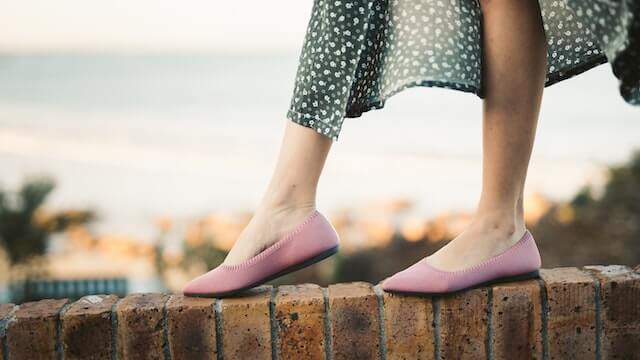
One major disadvantage that heels have is that long-term wear can cause your achilles tendon to shrink, and that could lead to injury while engaging in other exercises like jogging, even if you’re wearing appropriate footwear at the time.
Are Ballet Flats Better For Professional Environments?
Typically ballet flats are too casual for some professional environments and should be left to more casual situations or work environments. This is especially true if you’re meeting with customers and need to put forward a clean and polished appearance, and that is where heels can shine as the best option.
The downside to wearing heels during your workday is that they’re not always comfortable, especially if you’re on your feet for a large part of the day of attending client-facing meetings.
You can try to limit the heel thickness and length to keep more comfort while keeping your polished appearance, or you can consider keeping a pair of flat shoes under your desk when you’re not meeting with clients.
Are Ballet Flats Suitable In All Situations?
Historically ballet flats and flat shoes in general, have been considered a more casual shoe that shouldn’t be worn in all situations. However, the attitudes and fashions have changed as younger people are looking to stay comfortable rather than focus solely on appearance.
Flat shoes are becoming more acceptable in offices, events, going out at night, and even some people are wearing flats instead of heels for their wedding to stay comfortable for a long day.
If you’re able to slip a supportive insole into your ballet flats, they become a very affordable, supportive, and comfortable option for almost any occasion, especially if that’s your style and the shoes match your clothes.
Are Ballet Flats Better Than Heels For Most Situations?
Ultimately your personal preference should determine whether you wear ballet flats or heels. Both have issues when worn for long periods of time, but ballet flats can be easily modified with extra support from a removable insole at a fairly minimal cost.
However, consider the environment you’re in and pick the best shoe, which for some situations may not be either a ballet flat or heel, such as hospitals where you may need to wear specialty nursing shoes to keep yourself safe and where standing for 8-14 hours in your day is a real possibility.
If you were to wear ballet flats or heels long-term and for long periods on your feet, you’re almost guaranteeing problems later in life, whether that’s to your feet or to your hips, knees, and back.
Frequently Asked Questions
Are ballet flats better than heels for nurses?
When it comes to choosing footwear for nurses, ballet flats and heels are not the ideal options. While ballet flats may provide a more comfortable alternative to high heels, they still lack the necessary support and cushioning that nurses require during their long shifts. Both ballet flats and heels typically lack arch support, shock absorption, and stability, which are essential for maintaining proper posture and preventing foot and leg fatigue. Nurses are constantly on their feet, walking, standing, and often lifting heavy objects or assisting patients, which puts a significant amount of strain on their lower extremities. It’s crucial for nurses to prioritize footwear that offers sufficient support, stability, and comfort, such as nursing shoes specifically designed for the demands of the profession.
What are the risks of wearing heels for nurses?
Wearing heels for extended periods can pose several risks and discomforts for nurses. Heels can alter the natural alignment of the feet, causing excessive pressure on certain areas and leading to foot pain, bunions, corns, and calluses. The elevated heel position can also strain the calf muscles and contribute to muscle fatigue and discomfort. Additionally, the lack of arch support and shock absorption in heels can result in poor posture, which may lead to back pain and spinal misalignment. Nurses need to prioritize their own well-being and choose footwear that provides adequate support, stability, and comfort to withstand the demands of their profession.
What should nurses look for in suitable footwear?
Nurses should prioritize several factors when choosing suitable footwear. First and foremost, comfort is paramount. Look for shoes with cushioning and support in the midsole and heel areas, as well as ample arch support to maintain proper foot alignment. The shoes should have a sturdy and slip-resistant outsole to provide stability and prevent slips and falls, especially in healthcare environments where spills or wet surfaces are common. It’s also important to consider the breathability of the material, as nurses may spend long hours wearing their shoes. Additionally, opt for shoes with adjustable closures, such as laces or straps, to ensure a secure and customized fit. Investing in nursing-specific shoes that are designed with the unique needs of healthcare professionals in mind is highly recommended.
Can nurses wear stylish footwear while on duty?
While comfort and functionality are essential, it is possible for nurses to find stylish footwear options that meet their professional requirements. Many reputable brands now offer nursing shoes in a variety of styles, colors, and designs, allowing nurses to express their personal style while ensuring the necessary comfort and support. From athletic-inspired shoes to clogs and slip-ons, there are fashionable options available that don’t compromise on functionality. It’s important to strike a balance between style and practicality, ensuring that the chosen footwear meets the specific demands of the nursing profession. By prioritizing comfort, support, and the requirements of their workplace, nurses can find footwear that blends style with functionality to keep them feeling and looking their best during their shifts.
You may also like
Are Nurses Happy?
Nurses are often on the frontline of healthcare, keeping patients comfortable and cared for while…
Skechers Sport Women’s Valeris Fashion Sneaker Review
Sketchers is a brand renowned for the lifestyle it promotes: healthy and sporty. These striking…
Skechers Sport Women’s D’Lites Non-Memory Foam Review
The Skechers Sport Women’s D Lites is a life saver among the women’s shoe represents…
Skechers Shape Ups Womens Kinetix Response Shoes Review
This model of Skechers Shape Ups Womens shoes is far from any sports shoe that…
What is the hardest course in nursing school?
A question that often looms large for nursing students and those considering this challenging yet…
Skechers Performance Women’s Go Walk 3 Lace-Up Review
Establishing a healthy lifestyle is important, a daily walking-based routine will make you feel young…
